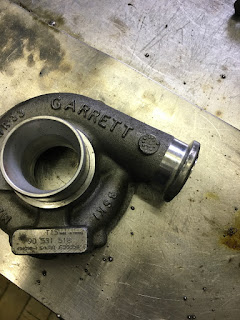And during that break, I simply decided to get the turbo in running order. The first (and one of the more simple tasks) was to to modify the turbine housing to get a boost-reference port for the wastegate.
Then secondly, because some numpty (that'll be me, thank you) put an exhaust where the oil-drain wanted to go, I had to fabricate a slightly more elaborate oil-drain-pipe than I originally anticipated.
(The picture actually shows the final version, if you compare it to the video clip and some of the pictures above and below, you will notice, that this wasn't exactly the only one built... 😏 )
As I pointed out before, I was a tad grumpy that day, so I decided to hook up a fuel line, plug some of the open ports on the inlet rubbers and see what happens next.
To my utmost surprise, it fired up more or less instantly and after somewhat clearing its throat it fired up.
One of the backfires "fine-tuned" my boost gauge and inspired it to from here onwards give some rather "optimistic" boost readings. (That's with the engine not even running.)
A bit more fine tuning and well the whole engine and setup proved to be hopelessly overbuilt as it lasted more than a quarter mile already.
Next step will now REALLY be to swap out the inlet-rubbers for the ones, with plug vacuum ports and space them in a bit to clamp the inlet manifold a bit tighter. Oh and a seat might come in handy, sitting on a rolled up rag is dead cool, but not exactly compliant with some of the rules and regulations of the racing bodies I want to take part in OR local vehicle road safety legislation. And talking of the latter as some people dropped me DMs on Instagram - nope, I don't see a simple legal way to get this on the road in Austria. Might be a different game in Germany or some other European countries, but I have received a big, fat "no way, mate" from the local authorities, when I presented the whole project to them.




































